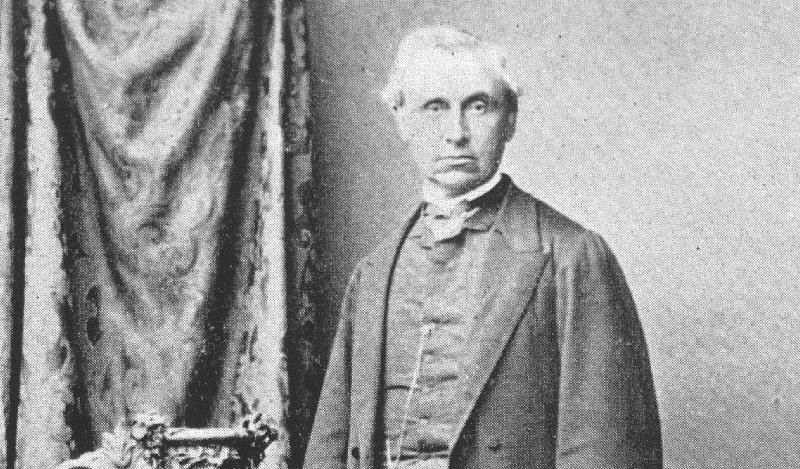
BROWN, Dr Walter MRCS, MD (Edin) (1821-1897) (fl 1857-1897)
Dr Walter Brown of Bristol, visited his brothers Alfred and Arthur who had fled England to Australia to escape catching consumption, a terrible disease which had already claimed two of the family. His father, John Brown of Brislington, a suburb of Bristol, was an architect who had hoped that Walter would follow him in that profession but he chose otherwise. At 16, Walter was apprenticed for three years to a reputable surgeon in Bristol, a Mr Brandon, and then studied at the University of Edinburgh where he qualified MRCS in 1843. He twice visited his brothers in Queensland returning to gain his doctorate degree by thesis in 1846, shortly before heading for a new life at Parramatta.[1]
In the spring of 1857, he purchased the practice of Dr Thomas Parsons. He became a tenant of Sir George Wigram Allen who owned the red brick house, which he named Brislington, in George Street. He was well suited to his vocation as a family physician with his commanding presence, quiet dignity, a fine sense of humour and a fanatical conception of the duty that lay before him. In August 1858, he married Sigismunda, daughter of John Brown of Coulston, of Upper Paterson in the Hunter Valley. Sigismunda, born in Copenhagen, was a fine horsewoman and attended her husband during their early married life on his calls in the neighbouring towns of Ryde, Liverpool, Windsor and Penrith.[2]
With the imminence of war in the Crimea, on 3 September, 1860, the townspeople of Parramatta met to discuss the formation of a Volunteer Corps. By the end of the month 50 men had joined and in November met to discuss the rules of their organisation. At this meeting they elected Dr. Walter as their captain. The first review was held in the Park when the ladies of the town, represented by Miss Bobart, the rector’s daughter, presented the Parramatta Rifles with a set of colours, ‘a very handsome silk one … ‘ with the words ‘Defence’, their motto, and the letters ‘PVR’ embroidered on it. After lunch, the men reformed and marched to Brislington where they presented the colours to their captain. The ladies of the town next worked tirelessly to raise funds for instruments for the Volunteers band. [3]
In the early sixties, Dr Walter Brown and Dr George Pringle worked amicably together as honorary medical officers on the staff of the Parramatta District Hospital which was gaining a reputation in the district as a medical establishment, rather than just as a benevolent institution for the aged and infirm. Whereas Dr Pringle was the leading light in the towns Cricket Club, Brown had formed the Rifle Club and was behind the formation of the Range, located on the north side of town. Brown was also a keen supporter of St John’s Church with his family and servants..[4]
In addition to being appointed to The King’s School Council, he was appointed official coroner in the town. These tasks, in addition to his normal busy practice and hospital duties, together with his interest in the Volunteer Rifles, made him decide to resign from the latter to conserve his time. The unit petitioned him to stay on and he was so flattered that he tried to have his resignation withdrawn. Army authorities disregarded his letter and accepted his resignation, until pressure from within the unit itself on the army heirachy, caused the decision to be reversed and promoted Brown to major.[5]
In the field of medicine, Brown had become renowned as one of a few surgeons able to successfully remove ovarian cysts. Known as ‘ovarian dropsy’, operations generally resulted in high mortality because of the complications of peritonitis, septicaemia or internal haemorrhage. Brown achieved some skill in performing such operations, aided greatly by the use of Lister’s newly found carbolic antiseptic and in the use of anaesthetic. The noted case concerned his first attempt, made upon a fifty year old woman of Bowral. The suffering woman was brought to Parramatta in a dray; the operation was conducted in a bedroom at Old Government House, then a fashionable boarding house conducted by a Mrs Abrahams. Infinite trouble was taken in preparing the room to make it antiseptic with carbolic. The operation was successfully undertaken on a mattress placed on two kitchen tables, Brown was assisted by Drs Rutter and Waugh. One of the end results of this scene was the realisation that operations should be performed in a hospital with skilled nurses assisting, which then became a procedure, followed by Brown, supported by Rutter, urging the hospital Board to build an separate room solely for the use of operations.[6]
Walter Brown was a leader in the move towards a new hospital for Parramatta during the 1880’s and although his efforts helped towards the project’s success, he died on 16 December, 1897, at least seeing the new building almost complete.
References
[1] K. McA Brown, Medical History, p. 68.
[2] Ibid, pp. 70-72.
[3] J. Jervis, Cradle City, p. 130;K. McA Brown, Medical History, p. 75.
[4] K. McA Brown, Medical History, pp. 80-3. The Rifle Range, it is believed was in the vicinity of the Glen Quarry.
[5] Ibid, p.89.
[6] Ibid, pp. 113-16.
![]()
by John McClymont, Parramatta Historian, April 1999.
From the manuscripts donated to the Parramatta Heritage and Visitor Centre, 2014



